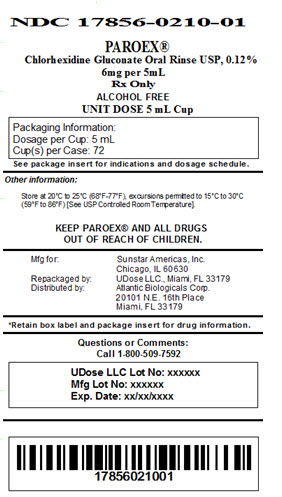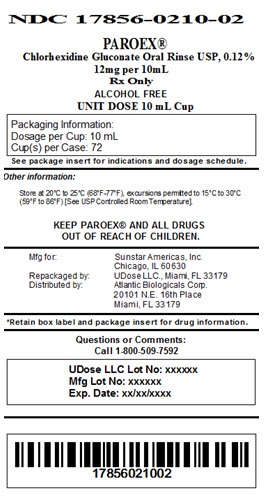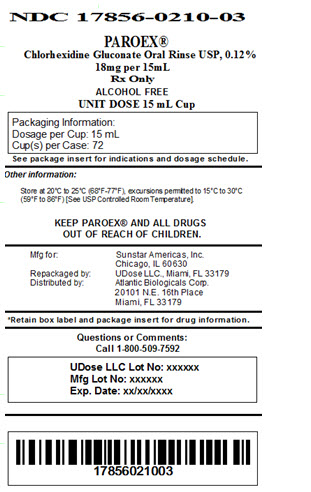PAROEX- chlorhexidine gluconate rinse
PAROEX by
Drug Labeling and Warnings
PAROEX by is a Prescription medication manufactured, distributed, or labeled by ATLANTIC BIOLOGICALS CORP.. Drug facts, warnings, and ingredients follow.
Drug Details [pdf]
-
DESCRIPTION: Paroex® is an oral rinse containing 0.12% chlorhexidine gluconate (1,1'-hexamethylene bis [5-(p-chlorophenyl) biguanide] di-D-gluconate) in a base containing deionized water, propylene glycol, glycerin, polyoxyl 40 hydrogenated castor oil, mint flavor, potassium acesulfame, FD&C Red #40 and D&C Red #33. Paroex® is a near-neutral solution (pH range 5-7). Chlorhexidine gluconate is a salt of chlorhexidine and gluconic acid. Its chemical structure is:

-
CLINICAL PHARMACOLOGY
CLINICAL PHARMACOLOGY:Paroex® provides antimicrobial activity during oral rinsing. The clinical significance of chlorhexidine gluconate's antimicrobial activities is not clear. Microbiological sampling of plaque has shown a general reduction of counts of certain assayed bacteria, both aerobic and anaerobic, ranging from 54-97% through six months' use.
Use of chlorhexidine gluconate oral rinse in a six-month clinical study did not result in any significant changes in bacterial resistance, overgrowth of potentially opportunistic organisms or other adverse changes in the oral microbial ecosystem. Three months after chlorhexidine gluconate use was discontinued, the number of bacteria in plaque had returned to baseline levels and resistance of plaque bacteria to chlorhexidine gluconate was equal to that at baseline.
-
PHARMACOKINETICS
PHARMACOKINETICS: Pharmacokinetics studies with 0.12% chlorhexidine gluconate oral rinse indicate approximately 30% of the active ingredient is retained in the oral cavity following rinsing. The retained drug is slowly released into the oral fluids. Studies conducted on human subjects and animals demonstrate chlorhexidine gluconate is poorly absorbed from the gastrointestinal tract. The mean plasma level of chlorhexidine gluconate reached a peak of 0.206 µg/g in humans 30 minutes after they ingested a 300 mg dose of the drug. Detectable levels of chlorhexidine gluconate were not present in the plasma of these subjects 12 hours after the compound was administered. Excretion of chlorhexidine gluconate occurred primarily through the feces (~90%). Less than 1% of the chlorhexidine gluconate ingested by these subjects was excreted in the urine.
-
INDICATIONS & USAGE
INDICATIONS AND USAGE: PAROEX®(Chlorhexidine Gluconate Oral Rinse USP, 0.12%) is indicated for use between dental visits as part of a professional program for the treatment of gingivitis as characterized by redness and swelling of the gingivae, including gingival bleeding upon probing. Paroex® has not been tested among patients with acute necrotizing ulcerative gingivitis (ANUG). For patients having coexisting gingivitis and periodontitis, see PRECAUTIONS.
- CONTRAINDICATIONS
-
WARNINGS
WARNINGS: The effect of Paroex® on peridontitis has not been determined. An increase in supragingival calculus was noted in clinical testing in chlorhexidine gluconate oral rinse users compared with control users. It is not known if chlorhexidine gluconate oral rinse use results in an increase in subgingival calculus. Calculus deposits should be removed by a dental prophylaxis at intervals not greater than six months. Anaphylaxis, as well as serious allergic reactions, have been reported during postmarketing use with dental products containing chlorhexidine. See CONTRAINDICATIONS.
-
PRECAUTIONS
PRECAUTIONS:
GENERAL
- For patients having coexisiting gingivitis and periodontitis, the presence or absence of gingival inflammation following treatment with Paroex® should not be used as a major indicator of underlying periodontitis.
- Paroex® can cause staining of oral surfaces, such as tooth surfaces, restorations, and the dorsum of the tongue. Not all patients will experience a visually significant increase in toothstaining. In clinical testing, 56% of chlorhexidine gluconate oral rinse users exhibited a measurable increase in facial anterior stain, compared to 35% of control users after six months; 15% of chlorhexidine gluconate oral rinse users developed what was judged to be heavy stain, compared to 1% of the control users after six months. Stain will be more pronounced in patients who have heavier accumulations of unremoved plaque. Stain resulting from use of Paroex® does not adversely affect health of the gingivae or other oral tissues.Stain can be removed from most tooth surfaces by conventional professional prophylactic techniques. Additional time may be required to complete the prophylaxis. Discretion should be used when prescribing to patients with anterior facial restorations with rough surfaces or margins. If natural stain cannot be removed from these surfaces by a dental prophylaxis, patients should be excluded from Paroex® treatment if permanent discoloration is unacceptable. Stain in these areas may be difficult to remove by dental prophylaxis and on rare occasions may necessitate replacement of these restorations.
- Some patients may experience an alteration in taste perception while undergoing treatment with Paroex® (Chlorhexidine Gluconate Oral Rinse USP, 0.12%). Rare instances of permanent taste alteration following chlorhexidine gluconate oral rinse use have been reported via post-marketing surveillance.
-
PREGNANCY
Pregnancy:
Teratogenic Effects Pregnancy Category B. Reproduction studies have been performed in rats and rabbits at chlorhexidine gluconate doses up to 300 mg/kg/day and 40 mg/kg/day, respectively, and have not revealed evidence of harm to fetus. However, adequate and well-controlled studies in pregnant women have not been done. Because animal reproduction studies are not always predictive of human response, this drug should be used during pregnancy only if clearly needed.
-
NURSING MOTHERS
Nursing Mothers: It is not known whether this drug is excreted in human milk. Because many drugs are excreted in human milk, caution should be exercised when Paroex® oral rinse is administered to nursing women.
In parturition and lactation studies with rats, no evidence of impaired parturition or of toxic effects to suckling pups was observed when chlorhexidine gluconate was administered to dams at doses that were over 100 times greater than that which would results from a person's ingesting 30 mL (2 doses) of chlorhexidine gluconate per day.
- PEDIATRIC USE
-
CARCINOGENESIS & MUTAGENESIS & IMPAIRMENT OF FERTILITY
Carcinogenesis, Mutagenesis, and Impairment of Fertility: In a drinking water study in rats, carcinogenic effects were not observed at doses up to 38 mg/kg/day. Mutagenic effects were not observed in two mammalian in vivo mutagensis studies with chlorhexidine gluconate. The highest doses of chlorhexidine used in a mouse dominant-lethal assay and a hamster cytogenetics test were 1000 mg/kg/day and 250 mg/kg/day, respectively. No evidence of impaired fertility was observed in rats at doses up to 100 mg/kg/day.
-
ADVERSE REACTIONS
ADVERSE REACTIONS: The most common side effects associated with chlorhexidine gluconate oral rinse are: 1) an increase in staining of the teeth and other oral surfaces; 2) an increase in calculus formation; and 3) an alteration in taste perception; see WARNINGS and PRECAUTIONS.
Oral irritation and local allergy-type symptoms have been spontaneously reported as side effects associated with use of chlorhexidine gluconate rinse. The following oral mucosal side effects were reported during placebo-controlled adult clinical trails: aphthous ulcer, grossly obvious gingivitis, trauma, ulceration, erythema, desquamation, coated tongue, keratinization, geographic tongue, mucocele, and short frenum. Each occurred at a frequency of less than 1.0%. Among post marketing reports, the most frequently reported oral mucosal symptoms associated with chlorhexidine gluconate oral rinse are stomatitis, gingivits, glossitis, ulcer, dry mouth, hypesthesia, glossal edema, and paresthesia. Minor irritation and superficial desquamation of the oral mucosa have been noted in patients using chlorhexidine gluconate oral rinse. There have been cases of parotid gland swelling and inflammation of the salivary glands (sialadenitis) reported in patients using chlorhexidine gluconate oral rinse.
- OVERDOSAGE
-
DOSAGE & ADMINISTRATION
DOSAGE AND ADMINISTRATION: Paroex® (Chlorhexidine Gluconate Oral Rinse USP, 0.12%) therapy should be initiated directly following a dental prophylaxis. Patients using Paroex® should be reevaluated and given a thorough prophylaxis at intervals no longer than six months. Recommended use is twice daily, oral rinsing 30 seconds, morning and evening after toothbrushing. Usual dosage is 15 mL of undiluted Paroex®. Patients should be instructed not to rinse with water, or other mouthwashes, brush teeth, or eat immediately after using Paroex®. Paroex® is not intended for ingestion and should be expectorated after rinsing.
-
HOW SUPPLIED
HOW SUPPLIED:
Paroex® is supplied as a pink liquid in the following sizes:
4 fl oz (118 ml) (NDC: 52376-021-04) amber plastic bottles with child-resistant cap.
16 fl oz (473 ml) (NDC: 52376-021-02) amber plastic bottles with child-resistant cap, individually shrink wrapped with a dosage cup.STORE at 20ºC to 25ºC (68ºF to 77ºF), excursions permitted to 15ºC to 30ºC (59ºF to 86ºF) [See USP controlled room temperature].
Rx Only
Keep Out of Reach of Children.
Manufactured for: Sunstar Americas, Inc., Chicago, IL 60630
Revised: July 2014
-
To open, press down while turning the cap. To seal, turn until cap clicks and is tight.
Directions for Use: Fill dosage cup to the fill line (15 mL). Swish in your mouth undiluted for 30 seconds, then spit out. Use after breakfast and before bedtime. Or, use as prescribed by your dentist.
Note: To minimize medicinal taste, do not rinse with water immediately after use.
Rx Only.
Keep Out Of Reach Of Children.
-
What to expect when using Paroex® (chlorhexidine gluconate Oral Rinse USP, 0.12%):
Your dentist has prescribed Paroex® to treat your gingivitis - to help reduce the redness and swelling of your gums, and also to help you control any gum bleeding.
Use Paroex® regularly, as directed by your dentist, in addition to daily brushing and flossing. Spit out after use. Paroex® should not be swallowed.
If you develop allergic symptoms such as skin rash, itch, generalized swelling, breathing difficulties, light headedness, rapid heart rate, upset stomach or diarrhea, seek medical attention immediately. Paroex® should not be used by persons who have a sensitivity to it or its components.
Paroex® may cause some tooth discoloration, or increases in tartar (calculus) formation, particularly in areas where stain and tartar usually form. It is important to see your dentist for removal of any stain and tartar at least every six months, or more frequently if your dentist advises.
- Both stain and tartar can be removed by your dentist or hygienist. Chlorhexidine gluconate oral rinse may cause permanent discoloration of some front-tooth fillings.
- To minimize discoloration, you should brush and floss daily, emphasizing areas which begin to discolor.
- Paroex® may taste bitter to some patients and can affect how foods and beverages taste. This will become less noticeable in most cases with continued use of Paroex®.
- To avoid taste interference, rinse with Paroex® after meals. Do not rinse with water or other mouthwashes immediately after rinsing with Paroex®.
If you have any questions or comments about Paroex®, contact your dentist, pharmacist or Sunstar Americas, Inc. at 1-800-528-8537. Call your health care provider for medical advice about side effects. You may report side effects to FDA at 1-800-FDA-1088.
STORE at 20ºC to 25ºC (68ºF to 77ºF), excursions permitted to 15ºC to 30ºC (59ºF to 86ºF) [See USP controlled room temperature].
Manufactured for: Sunstar Americas, Inc., Chicago, IL 60630
-
Principal Display Panel
NDC: 17856-0210-1
5ml Unit Dose Cup
72 units in a Box
Distributed by:
Atlantic Biologicals Corp
Miami Fl 33179

-
Principal Display Panel
NDC: 17856-0210-2
10 ml Unit Dose Cup
72 units in a Box
Distributed by:
Atlantic Biologicals Corp
Miami Fl 33179

-
Principal Display Panel
NDC: 17856-0210-3
10 ml Unit Dose Cup
72 units in a Box
Distributed by:
Atlantic Biologicals Corp
Miami Fl 33179

-
INGREDIENTS AND APPEARANCE
PAROEX
chlorhexidine gluconate rinseProduct Information Product Type HUMAN PRESCRIPTION DRUG Item Code (Source) NDC: 17856-0210(NDC:52376-021) Route of Administration ORAL Active Ingredient/Active Moiety Ingredient Name Basis of Strength Strength Chlorhexidine Gluconate (UNII: MOR84MUD8E) (Chlorhexidine - UNII:R4KO0DY52L) Chlorhexidine Gluconate 1.2 mg in 1 mL Product Characteristics Color Score Shape Size Flavor MINT (Mint Flavor) Imprint Code Contains Packaging # Item Code Package Description Marketing Start Date Marketing End Date 1 NDC: 17856-0210-1 5 mL in 1 CUP, UNIT-DOSE; Type 0: Not a Combination Product 09/20/2019 2 NDC: 17856-0210-2 10 mL in 1 CUP, UNIT-DOSE; Type 0: Not a Combination Product 09/20/2019 3 NDC: 17856-0210-3 15 mL in 1 CUP, UNIT-DOSE; Type 0: Not a Combination Product 09/20/2019 Marketing Information Marketing Category Application Number or Monograph Citation Marketing Start Date Marketing End Date ANDA ANDA076434 10/31/2014 Labeler - ATLANTIC BIOLOGICALS CORP. (047437707) Establishment Name Address ID/FEI Business Operations ATLANTIC BIOLOGICALS CORP. 047437707 repack(17856-0210) , relabel(17856-0210)
Trademark Results [PAROEX]
Mark Image Registration | Serial | Company Trademark Application Date |
|---|---|
 PAROEX 85688455 4518500 Live/Registered |
Sunstar Americas, Inc. 2012-07-27 |
 PAROEX 78513952 not registered Dead/Abandoned |
Sunstar Americas, Inc. 2004-11-09 |
 PAROEX 76175912 not registered Dead/Abandoned |
SUNSTAR AMERICAS, INC. 2000-12-05 |
© 2025 FDA.report
This site is not affiliated with or endorsed by the FDA.